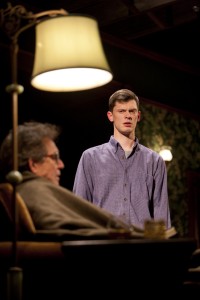
(left to right) Dale Place as Black Bird and Thomas Piper as Connor in afterlife: a ghost story. Photo by Andrew Brilliant/ Brilliant Pictures.
afterlife: a ghost story by Steve Yockey, New Repertory Theatre, 1/16/11-2/6/11, http://newrep.org/afterlife.php. Contains strong language.
Reviewed by Becca Kidwell
Steve Yockey’s afterlife: a ghost story should be subtitled an evening of one acts. While both acts of the play contain the same characters and themes, the familiarity ends there. Act I displays a realistic, yet mundane evening between a grieving couple; they are packing up the beach house where they used to live. They talk around the subject of their son’s death, but other than some yelling and “crying” they really remain stuck in one place until their house is washed away. Act II portrays a fantasy world (somewhere between heaven and hell) where the Danielle, Connor, and their son work out their grief. They receive the assistance of a postman, a proprietress, another ghost, and a bird puppet. afterlife: a ghost story has potential to transform into an interesting play if the first act removes ninety percent of its action and the second act has the chance to develop more fully. Continue reading
